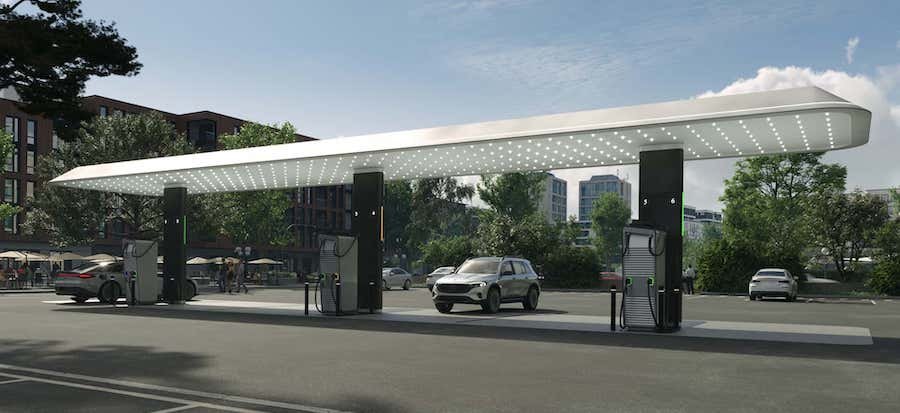Mercedes-Benz's Open-to-All-EVs Supercharger-Wannabe Network To Come Online in October

Early this year, the Stuttgart-based automaker announced it would start building its own DC fast-charging network. It said the US and Canada would be among the first to see these new locations. Mercedes-Benz estimated it could open around 400 charging hubs, each with roughly six stalls, by 2027 by working closely together with trusted dealerships.
The same statement promised energy dispensers with up to 350 kW capacity. It also showed renders of high-power charging stations that looked like the futuristic version of a gas station.
Now, Mercedes-Benz confirms that the first such locations will appear in Atlanta, US, Mannheim, Germany, and Chengdu, China. Named Mercedes-Benz Charging Hubs, these stations will include stalls with a maximum power output of up to 400 kW. They will also feature plugs with the CCS Combo 1, CCS Combo 2, NACS, and GB/T connectors. In North America, customers will see only the CCS Combo 1 and NACS ports.
Mercedes-Benz says any EV that will use its charging network will be able to take full advantage of its maximum power rating of 400 kW (a 50 kW improvement over the initial announcement) and charge faster. The automaker says this is possible thanks to an "intelligent charging management" system but doesn't go into detail explaining what it comprises.
All EVs on the market today have different charging curves. Take the Lucid Air and its 900V+ battery architecture as an example. Plugging into a 350-kW DC fast-charger at 1% state of charge (SoC) and replenishing the battery to around 20% SoC will allow the car to extract power at nearly the maximum rate. But as the energy storage unit fills up electrons, the rate at which it can suck energy from the grid gradually drops.
That can happen because the battery's internal resistance increases. The car's thermal management system can also negatively impact fast charging because its mission is to protect the high-voltage energy storage unit. A slower charging rate can also happen because the stall needs to stay at a certain safe operating temperature.
Mercedes-Benz might have learned from what charging networks like Electrify America or Tesla's Supercharger had to deal with and implemented a better cooling system for both the stall and the cable. That would be a great solution. It could technically eliminate the charger from the list of culprits that negatively impact a charging session by slowing the output.
The German marque says it will deploy 2,000 DC fast-charging points by the end of 2024, amounting to around 340 Charging Hubs worldwide. Tesla is already way ahead of Mercedes-Benz and will most likely comfortably keep its lead since it has introduced V4 stalls in Europe that are open to everyone and can be easily used through the Tap&Go system. Moreover, the American EV maker is already present globally with thousands of high-power charging stations.
Mercedes-Benz says its Charging Hubs will be located at select dealerships and include some creature comforts like restrooms and machines dispensing snacks or refreshments. The stations will also have security cameras installed and work seamlessly thanks to a Plug&Play system that starts charging as soon as the car or the payment information is recognized.
Some high-power charging stations might also have canopies with solar panels on top of them. The brand says it will provide customers with "green energy" wherever possible through specific electricity supply contracts.
Mercedes-Benz owners will be able to select and reserve a charging point. It's unclear if that stops others from using that particular plug for a while until they arrive to plug in or is just a courtesy system that lets other buyers of the brand's EVs know someone's on their way.
Besides having its own DC fast charging network, the German carmaker partnered with General Motors, Stellantis, BMW, Hyundai, Kia, and Honda to create an Ionity-like venture for North America.
Finally, Mercedes-Benz customers will see these new charging stations in their vehicle's updated infotainment navigation.
Related News
